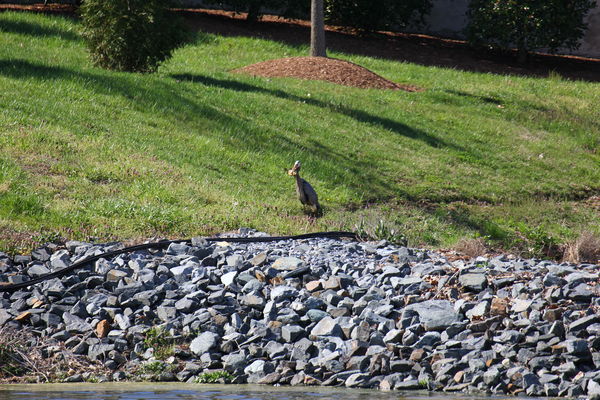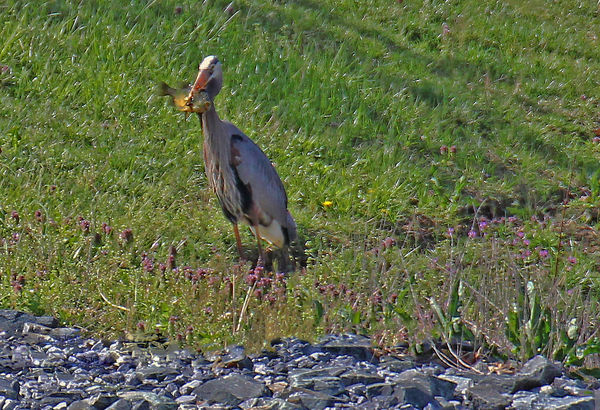Magnifing & cropping
Apr 3, 2016 16:41:26 #
I recently got a picture of a Great Blue Heron by one of our community ponds with a just captured fish in its mouth. Unfortunately the picture was (had to be) shot from about 150 yards away, and until it was magnified, I never noticed the fish. I was using my Tamron EF 70-300mm f/4.0 - 5.6 DI VC full frame lens on my 60D; the lens was fully extended.
I have tried several versions of enlarging and cropping the shot, but in all of them is the result been less than sharp as demonstrated.
Is it better to enlarge and then crop or should I be cropping first; Does it make any difference? Any suggestions for improvement of this picture would be appreciated.
The original JPEG and one cropped and enlarged version are attached.
I have tried several versions of enlarging and cropping the shot, but in all of them is the result been less than sharp as demonstrated.
Is it better to enlarge and then crop or should I be cropping first; Does it make any difference? Any suggestions for improvement of this picture would be appreciated.
The original JPEG and one cropped and enlarged version are attached.
Apr 3, 2016 16:53:24 #
JCam wrote:
I recently got a picture of a Great Blue Heron by ... (show quote)
Unfortunately, digital images are not like film images where one can crop a small portion of a negative and make a reasonably acceptable enlargement. Digital tends to go to hell in a handbasket under situations such as yours. There are some applications out there that can do that, with reasonable results, reasonable being the operative word there.
I'm not sure if either enlarge then crop or crop then enlarge is preferable. As in both cases you're making pixels where there weren't any.
You did do a reasonably good job of it here.
--Bob
Apr 3, 2016 17:59:42 #
rmalarz wrote:
Unfortunately, digital images are not like film images where one can crop a small portion of a negative and make a reasonably acceptable enlargement. Digital tends to go to hell in a handbasket under situations such as yours. There are some applications out there that can do that, with reasonable results, reasonable being the operative word there.
You should put a smilie at the end when you make jokes like that!
In fact film has exactly the same problem. Snip out a small section and trying to enlarge it beyond what is "reasonable" provides something that "tends to go to hell in a handbasket" very quickly.
Apr 3, 2016 18:05:00 #
Yes, there is functionally no difference between cropping first or last, but if you crop first and enlarge then at least you don't have to deal with a large a file.
As for software to "add pixels", you might find success with On One's Perfect Resize (it used to be called Genuine Fractals) - it can do a pretty good job within limits.
As for software to "add pixels", you might find success with On One's Perfect Resize (it used to be called Genuine Fractals) - it can do a pretty good job within limits.
Apr 3, 2016 20:47:45 #
It shouldn't matter whether you crop first or last. The big lesson here is to shoot in RAW. When you look at the download and enlarge either of the images, you can see the degradation in the picture. Much of that was caused by the process of "compressing" the file into a Jpeg. What some refer to as compressing is actually stripping data out of the file to reduce its size. Much more data would have been available to work with to make the crop in RAW.
Apr 3, 2016 23:55:23 #
Apaflo wrote:
You should put a smilie at the end when you make jokes like that!
In fact film has exactly the same problem. Snip out a small section and trying to enlarge it beyond what is "reasonable" provides something that "tends to go to hell in a handbasket" very quickly.
In fact film has exactly the same problem. Snip out a small section and trying to enlarge it beyond what is "reasonable" provides something that "tends to go to hell in a handbasket" very quickly.
I think not, Apaflo. Small portions of negatives can be cropped without going to hell in a hand basket, as digital is prone to do.
Been there. Done that.
--Bob
Apr 4, 2016 00:26:05 #
rmalarz wrote:
I think not, Apaflo. Small portions of negatives can be cropped without going to hell in a hand basket, as digital is prone to do.
Been there. Done that.
--Bob
Been there. Done that.
--Bob
It works exactly the same. A negative that has recorded resolution at any given number of line pairs per millimeter can be cropped and printed right up to that number of line pairs per millimeter. Crop it more or make it larger and there is exactly the same loss of quality that happens when the same thing is done with a digital image.
This is not a matter of opinion, it's a matter of fairly simple physics.
Moreover, you may claim to have been there and done that, but what you say proves that if you were there you missed out on the done that part. There are any number of folks here on UHH that have spent literally years in a darkroom, and we will all tell you the same thing. A very simple proof of concept is to just think about what you would see with a "grain focuser"!. A cropped and enlarged section that has no image quality left!
If you want to reply, then register here. Registration is free and your account is created instantly, so you can post right away.






